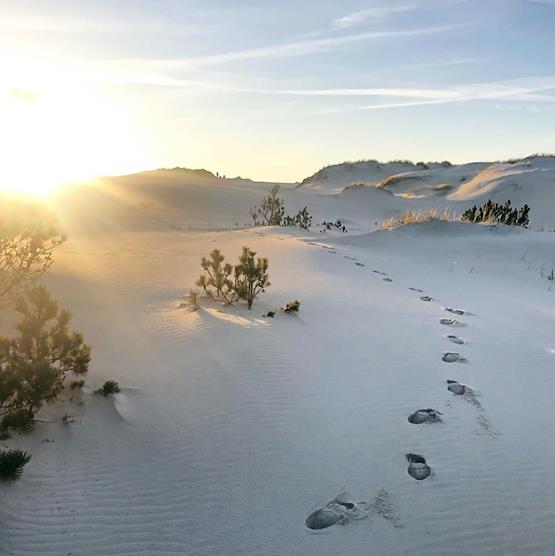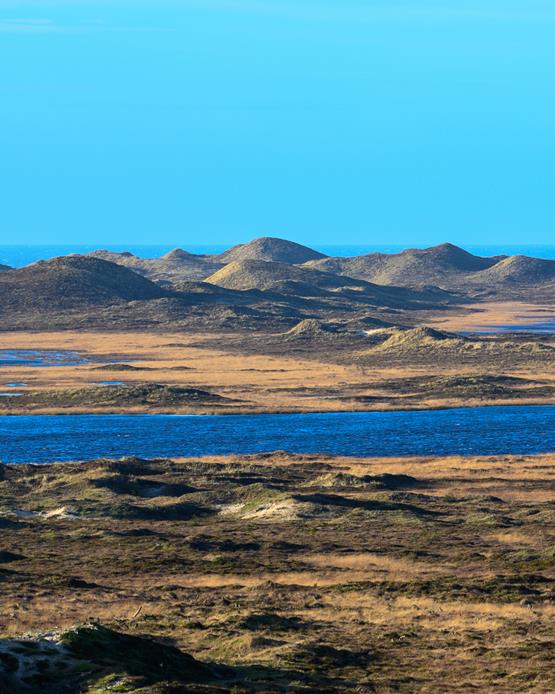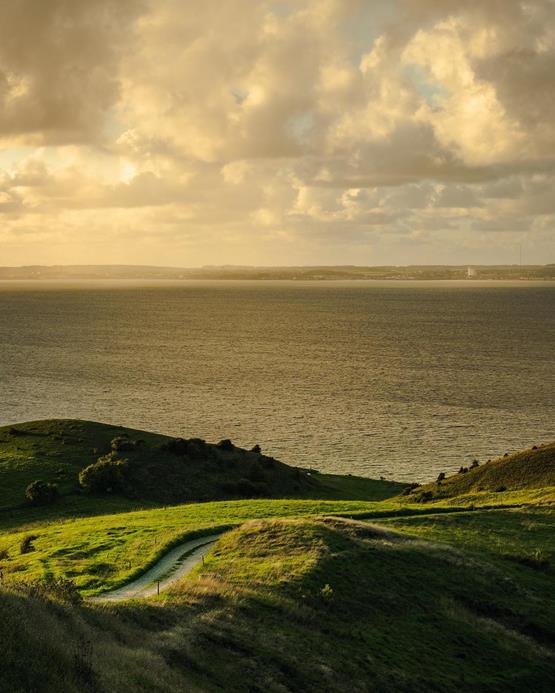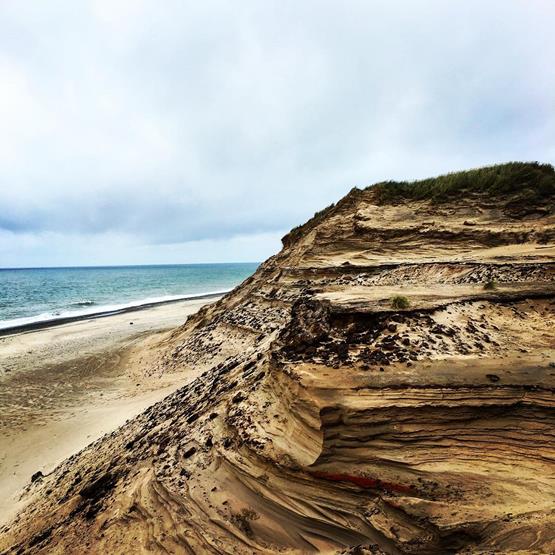At the top of Denmark in North Jutland, there is a wealth of wild nature experiences. Everything from magnificent forests to rugged beaches and extraordinary geological areas. See the nine best nature experiences here.
1. Nature experiences in the desert of North Jutland: Råbjerg Mile

250,000 people visit this nature experience in North Jutland every year, and it is not without reason.
The large hiking dune, the mile, is 300-400 years old and moves twenty meters a year. It is quite unusual for an entire nature area to move so much in a single year, but again, it is a hiking dune, so it is not so surprising that it hikes. Råbjerg Mile is protected.
Råbjerg Mile cannot be compared to any other nature experience in Denmark. Here nature feels really big, and man quite small. The highest point is 40 meters above sea level, and the mile consists of 3.5 million cubic meters of sand. It is therefore not entirely out of the question to call Råbjerg Mile the Desert of Denmark.
A desert full of life in North Jutland
In the sandy area you may be lucky enough to see traces of beach toads, salamanders, vipers and various birds and insects. Once there were many active hiking dunes in Denmark, today there is only Råbjerg Mile left, the others are either planted or smoked in the sea.
It is not difficult to get to Råbjerg Mile, you can take the local train to Hulsig Station and walk from there. There are also many parking options close to the mile. By car, it only takes about an hour to drive from Aalborg. When you are up there anyway, you can just as well take a trip to Grenen in Skagen, which is another wild nature experience in North Jutland.
2. Nature experiences at the top of North Jutland: The branch in Skagen

At the top of North Jutland, the Kattegat and the Skagerrak meet. Here you can get new wild nature experiences in North Jutland every time you visit. The sea shapes and creates the landscape. The branch in Skagen will therefore never look exactly the same.
It is a very special nature experience to stand on Grenen, because you can dip your feet in the Kattegat and Skagerrak at the same time.
If you look up, there is a high probability of seeing a bird of prey or two. More than 20 different birds of prey make their way past Skagen in one of Northern Europe’s largest bird migrations in the spring.
In 2007, a land area of 670 hectares of Grenen in Skagen and a surrounding sea area of 1,000 hectares have been protected.
A rapidly growing nature experience in North Jutland
On average, Grenen grows 6-8 meters a year. In some years it has grown more than 10-12 meters. It is not small amounts of sand that are needed for such a growing plant.
Every year, the ocean’s current transports an average of 800,000 cubic meters of sand and gravel to Grenen. This is roughly equivalent to the cargo in 80,000 filled trucks that could reach from Skagen to Berlin if they kept in one row.
The branch is the tip of Skagen’s Odde. The headland begins approximately 30 kilometers south of Skagen at the foot of the coastal cliff between Frederikshavn and Hirtshals. This makes Skagens Odde one of the world’s largest odd formations, and thus also an impressive nature experience in North Jutland.
The sandy tip was formed after the ice age 7-8,000 years ago, and is to this day one of the country’s most beloved protections. The branch receives about one million guests a year.
3. Nature experiences in North Jutland’s largest forest: Rold Forest

Denmark’s second largest forest is composed of several different forests that spread over 80 square kilometers. Rold Skov is only about 30 minutes from Aalborg.
Rold Skov is a magical forest where old trees, which can be up to 300 years old, grow even larger and even more crooked. It is therefore not difficult to imagine that the trolls thrive in Rold Skov. One of the smaller forests is named after the invisible inhabitants, it is called the troll forest.
Besides trolls, several believe they have seen wolves in the forest, but this has not yet been confirmed with certainty. Several areas in Rold Skov are protected.
Rold Skov is for the whole family
There are plenty of wild nature experiences in Rold Forest, as the area houses forests, bogs, meadows and springs. There are plenty of nature experiences for adults and children in the forest.
Rold Skov originated during the ice age, and therefore you can find chalk in the ground in some places. In addition to relics from the past, you can also see the beautiful and rare orchid ladies’ shoes and animals such as otters, crowned animals and many different birds.
There are actually 200 crowned animals in the forest complex. The large mammals are remnants of the original Jutlandic tribe, and probably only slightly “contaminated” by genes from escaped captive animals.
4. Nature experiences on the islands of North Jutland: Læsø

NOTE: Wait to go to Læsø until there is no longer a risk of infection and becoming infected with covid-19.
On Læsø you get a spectacular nature experience in North Jutland. Rønnerne, located on the southern part of Læsø, is one of the largest beach meadow areas in Denmark. The area moves half an inch upwards every year. In the soil there is methane, which forms toxic hydrogen sulphide at the surface. That is why the rivers do not grow with plants.
The rowan is a true paradise for birds because there is a lot of food in the area, especially for those birds that like aquatic plants.
It is also on Rønnerne that the island’s biggest tourist attraction is located, namely Sydehytten from 1991. In Sydehytten, salt from the beach meadow’s subsoil is extracted – just as it was done back in the year 1300-1550.
The high salt content also gives special plants optimal living conditions. This applies, among other things, to the small herb evenings, which thrive in Rønnerne.
In 1980, approximately 1750 hectares on the southern Læsø were protected.
Læsø for (land and) water dogs
There are less than 2,000 inhabitants on the 118 km 2 large North Jutland island, so Læsø is larger than both Anholt and Samsø.
The island has a beautiful coastline that is about 100 kilometers long. There is plenty of opportunity to take a dip in the Kattegat, which is the sea Læsø is surrounded by.
If you are more into watching the water, then there are particularly good opportunities below Hornekshuset. Hornekshuset In 2019, two binoculars were installed. Hornekshuset is located on the northern part of Læsø.
To get to Læsø you can take the Læsø ferry from Frederikshavn. It takes about 90 minutes and costs 70 kroner for adults.
5. Wild nature experiences in Hanstholm Wildlife Reserve

One of the wildest nature experiences you can get in North Jutland is to stand on top of Hanstholm Wildlife Reserve one early morning.
The highest point is 56 meters above sea level and goes by the name Isbjerg. Here you get a fantastic view of the protected field of 3,500 hectares. If you take binoculars with a spring morning, then you may be lucky enough to see cranes walking around the landscape. On a winter day, you might spot some crowned deer.
The area is a game reserve, which means that the wild animals have a special protection in relation to hunting and traffic is regulated.
North Jutland’s most rare plants?
Many rare plants, such as Scottish loess, grow in the vast dune heathland. A hike in the area can therefore be an extraordinary nature experience in North Jutland, if you spot the rare plant. Scottish loose stalk can be recognized by its glistening green leaves and its white flowers.
If you go really close, you can also smell it, because it smells a lot of celery.
In addition to the rare plant that grows on the coast, you can encounter heather, grasses and lichens. Further inland on the dry areas, the wavy pile dominates, but you can also see one, heart grass, tuberous meadweed and low scorching zones.
In the slightly more humid places, bell heather, long-leaved sundew, viper fat, spotted cuckoo grass, bog bulge and cranberries grow. So there is plenty to look at when you visit this extraordinary nature experience in North Jutland.
However, you should be aware that traffic in the landscape is extremely limited during the animals’ breeding season.
6. North Jutland’s harsh nature experience: Rubjerg Knude

The spectacular landscape at Rubjerg Knude in North Jutland is an impressive nature experience because it is large, deserted and rugged.
The knot rises its sand-covered top 90 meters above sea level, and can be seen from afar. The iconic Rubjerg Knude lighthouse, which can be bought as jewelery in Hjørring, stands proudly and majestically on top. It has been there since 1899.
The sea eats about a meter of the cliff annually, which means that the lighthouse has been dangerously close to the water. Fortunately, in 2019 it was moved by human intervention. The move was a lengthy one, as the lighthouse weighs 1,000 tons.
In 1948, Rubjerg Knude and surrounding areas were protected.
Go on a collection hunt in the dramatic surroundings
On the cliff you can really go on a collection hunt. Sea buckthorn thrives excellently in the harsh environment. In fact, it is Denmark’s largest sea buckthorn scrub found in Rubjerg Knude.
Between the orange berries, elder, hawthorn and spruce mix. The carriers attract birds, and the most characteristic breeding birds are thornbirds, thorn warblers and red-backed thorn warblers. When the wind blows hard from the northwest, you may be lucky enough to see Atlantic bird species such as guillemots, algae and puffins.
7. Experience views in North Jutland: Salgjerhøj and Hanklit

With its 89 meters, Salgjerhøj is the highest point on Mors by the green Limfjordsø. Here you get a very special nature experience in North Jutland with a sumptuous view.
To secure the beautiful area against commercial exploitation, Morsing resident Hanklit already bought the area in 1937, and now it is secured through a protection from 1966.
Find treasures on earth
A walk along the beach between Salgjerhøj and Hanklit is highly recommended. If you look down, you can find fossils. In the mole there are fossils of fish, snails, insects and plants. If the fossils are lying loose on the beach, feel free to take them home.
The best fossils are found on the shore when there are low tides. However, you should be aware that it is illegal to chop pieces out of the cliff.
If you are more into live animals, you can meet birds, deer and fast-moving hares.
8. Hiking in nature in Hammer Bakker

Heather-clad hills, beautiful views and deep gorges provide opportunities for extraordinary nature experiences in North Jutland’s Hammer Hills. This is probably also the reason why many Aalborgers visit the area’s walking routes. The hill country in North Jutland offers fantastic nature, and at the same time it is close to the city.
Hammer Bakker’s history dates back to the 15th and 16th centuries, when the hills were dominated by deciduous forest. Deforestation and cattle grazing put an end to the forest, and for the next 2-300 years Hammer Bakker was largely without forest.
However, it proved difficult to grow anything in the sandy soil, and in the late 1800s, conifers were planted in the hilly landscape. At the beginning of the 20th century, several parts of Hammer Bakker were protected, and the beautiful views you can see today became part of the package.
Magical nature experiences in North Jutland all year round
You can visit the area all year round. In summer you can pick blueberries and cranberries. In winter you can go skiing.
There is also a rich wildlife in Hammer Bakker. Here you can meet foxes, badgers and squirrels, all of which live side by side with many different birds that breed in the trees.
9. Single experience? Lodbjerg Klithede and Flade Sø

If you need a very special nature experience, where you can let your mind run free and enjoy nature all alone, then Lodbjerg Klithede is the perfect place.
The great dune is rarely visited by humans, and you will therefore, in all probability, be able to walk in solitude and take in the essence of nature. The area is also protected.
A nature experience in North Jutland with wild animals and good views
At Flat Lake, however, you can quickly encounter a fish or two. The lake houses an impressive fish stock with everything from perch to eel and pike. Otters also live in the water, but since they are very shy, you do not have to put your nose up to meet such a water-loving cousin.
On Lodbjerg Klitplantage is Lodbjerg Lighthouse, which was built in 1883. You can come up to the lighthouse for a modest payment of 25 kroner. From here you can see the landscape, which is dominated by sea, dunes, dunes, lakes and plantation.


